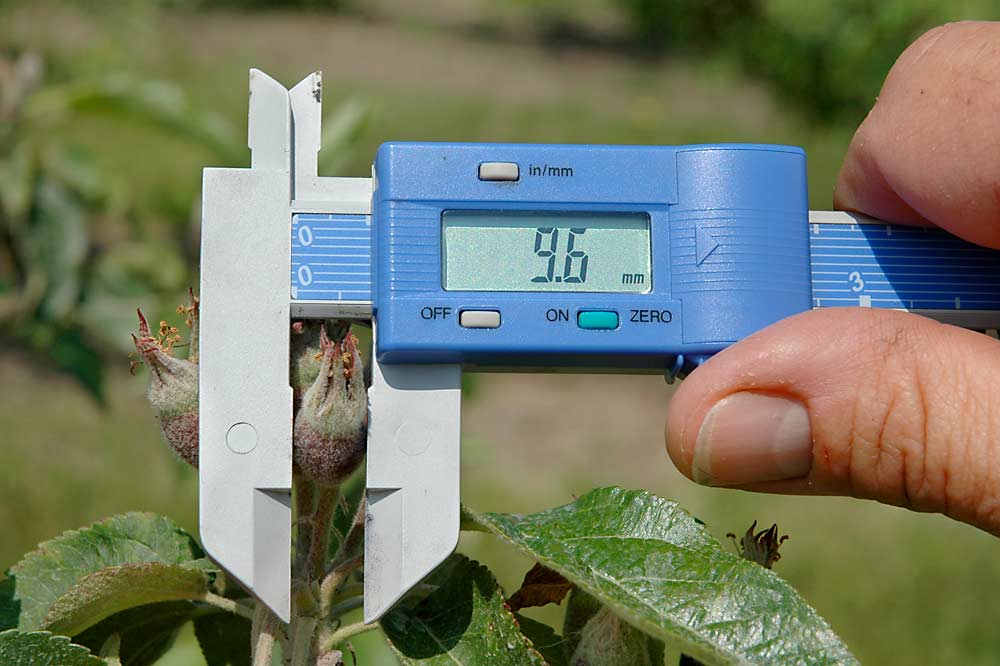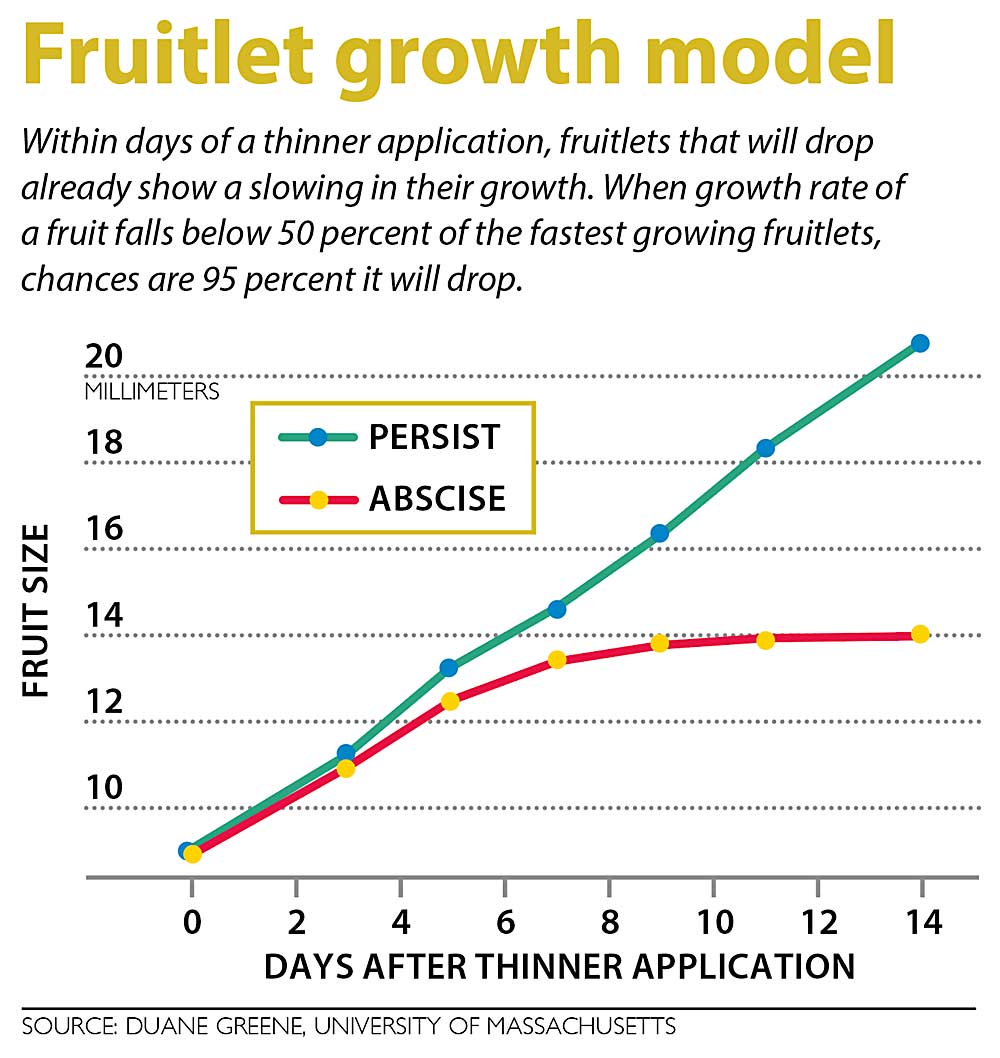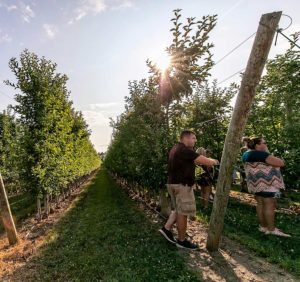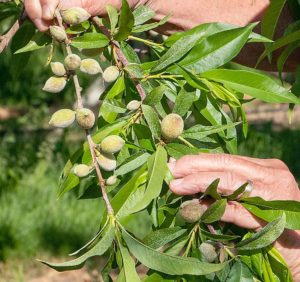
Editor’s note: While our March 15, 2022, issue focuses on emerging technology promising to take over the tedious tasks that inform precision crop load management, the foundation of using computer vision to count and size fruitlets to understand thinning efficacy is the fruitlet growth model developed well over a decade ago by University of Massachusetts professor Duane Greene and colleagues. To understand the physiology that underpins today’s technology, Good Fruit Grower decided to update a primer on precision thinning from 2014, based on a talk Greene gave during the Cornell University Fruit School. In the years since, modifications to this approach have aimed to reduce the workload, Greene said, such as Cornell’s Malusim model, by measuring fewer spurs and skipping the fruitlet numbering on each spur.
Over the past few years, apple growers should have gained confidence that they can chemically thin their apples and achieve pretty good results.
The gains have come through increased understanding of tree fruit physiology — how trees shed excess fruit and why.
There have been several key players in developing an understanding of how to effectively use thinners. One is Duane Greene at the University of Massachusetts, who spoke during the Cornell University In-Depth Fruit School (in early spring 2014).
Greene was selected to speak based on his long career studying plant growth regulators and, most recently, for his development of a way to determine how well thinners already applied have worked so that additional thinning can be done if needed — without danger of overthinning.
Quite simply, Greene’s “fruitlet model” involves accurately measuring the growth of selected fruit.
Greene found that apples growing at half the rate, or less, of fruit that persist to harvest will fall off, and that the growth rate of apples that will fall off begins to slow down as soon as three or four days after a thinner has been applied.
He measures the diameter of selected fruits three or four days after thinners are applied, and again three or four days later.
Greene collaborated with other researchers, Terence Robinson and Alan Lakso at Cornell University and Phil Schwallier at Michigan State University, in developing the fruitlet model.
They were working together to develop a carbohydrate model for predicting when apples could be thinned most effectively. That model shows that when apple trees are stressed by weather conditions that result in the tree producing less carbohydrate than growing fruit demands, some of that fruit will fall off the tree.
Adding more stress, like a chemical thinner, increases thinning. Weather monitoring allows prediction of periods when fruit is most susceptible to thinning, so that timing and rate of chemical application can be determined.
Thinning windows
As Greene explained during the fruit school, growers have several windows during which to thin apples.
The first opportunity is during bloom, when caustic materials like lime sulfur and fish oil will damage flowers, reduce pollination and lower fruit set.
The second is from petal fall to when fruits are 6 millimeters (mm) in diameter.
Then comes the “ideal” window when fruits are 7 to 15 mm in size. A third window is when fruits are 18 to 25 mm.
When fruits are larger than 25 mm, thinning is very difficult. Hand thinning, and the labor bill that goes with it, are the final determiners of how effective chemical thinning was.
Carbohydrate demand
Chemical thinning can be done about 28 days after petal fall, the time period in which fruits grow to about 25 mm in diameter, or just under 1 inch.
When fruit is small, from petal fall to 6 mm, some thinning is possible, Greene said. But since the fruit is small and growth is relatively slow, carbohydrate demand is not great. Fruit is more difficult to thin unless fruit is stressed. Sevin (carbaryl) and NAA (naphthaleneacetic acid) are thinners of choice, although NAD (naphthaleneacetamide) is useful on some varieties at this time. (A new thinner, Accede, joins this list for the 16- to 20-mm window in 2022, Greene said. See “New stone fruit thinner reduces hand labor.”)
Trees might become extremely stressed if temperatures are high, increasing carbohydrate demand, but light conditions are poor, resulting in lower photosynthesis. Excessive thinning can occur when nights are warm and days are cloudy. The carbohydrate model monitors these conditions and rates the potential for carbohydrate deficiency.
“Chemical thinning is most successful when fruits are from 7 to 14 mm,” Greene said. “Fruit growth is proceeding rapidly. At high temperatures and/or low light levels, excessive thinning is possible.”
Growers may need to lower chemical rates to prevent overthinning. Chemicals used at this time include NAA, carbaryl and BA, usually in combination. Thinning effects are additive, he said.
Greene said of the 18 to 25 mm size: “This is the period when it is very difficult to thin, even when there is a carbohydrate deficit. We have very few thinners that work well and consistently at this fruit size.”
Fruit growth model
Greene is best known for his work on the fruit growth model.
“To thin effectively, more than one thinner application is generally required,” he said. “We have had no way to tell if or how well thinners worked until after the thinning window of opportunity has passed. This model was developed to serve as a tool to assess the effects of previous thinners, usually within seven days of application.”
The fruitlet model is based on two observations: Fruit that persist will start to grow rapidly a few days after fertilization, and their growth will continue without interruption throughout the season; fruit destined to fall off will slow in growth well in advance of the time they actually fall off.

“Under most circumstances, measuring the reduction in fruit growth between four and seven days after thinner application has proved sufficient to determine if a fruit will continue to grow or to abscise,” Greene said. “All fruit that slow to a growth rate of 50 percent or less of the growth rate of the fruit that persist to harvest will ultimately stop growth and abscise.”
To put the information into action in your orchard:
—Select 10 to 20 spurs per tree on five to 10 trees and tag them before applying the thinner.
—Mark and identify individual fruits on each tagged spur. (Modifications developed under Cornell’s Malusim model have shown that fruitlet numbering isn’t necessary.)
—It generally requires at least four days after thinner application to note growth reduction on fruit destined to abscise. In cool years, this could take up to seven days.
—Using a caliper (a digital readout is handy), measure each fruitlet, starting no earlier than when it reaches 6 to
7 mm diameter and record each fruit’s size.
—Measure fruit at two- or three-day intervals and record measurements. As few as two measurements may be enough; one starting at four days after application and another three to four days later.
—Predict which fruitlets will drop off — those failing to grow at least half as fast as the fastest growing.
An accurate prediction can normally be made within seven days of application, Greene said, which allows time for a grower to make repeat applications since the fruit is still small enough to respond to thinners.
—by Richard Lehnert








Thanks for republishing this article by Richard Lehnert (God rest his soul) highlighting Dr. Greene’s excellent work on developing the fruitlet growth rate model. I’d like to note that I have a revised RECIPE for growers to implement the fruitlet growth rate model and make better chemical thinning decisions. The “RECIPE-Predicting fruit set using the fruitlet growth rate model” is available as a Fact Sheet on our website: https://ag.umass.edu/fruit/fact-sheets/hrt-recipe-predicting-fruit-set-using-fruitlet-growth-rate-model.